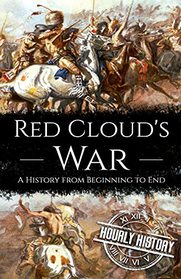Hourly History does a fine job of explaining the various factions important to this story and how they viewed each other. There were three main pressures on the Powder River lands: How the Indians used their lands, the Manifest Destiny belief of most of the immigrants moving West, and the Union forces before, during, and after the Civil War. The author was also knowledgeable about the pressures within and amongst the Indian tribal groups and how they treated each other, the land, and the resources on that land.
Red Cloud was a Lakota Indian (an important subculture of the Sioux Indians) who fought alongside the Cheyenne and Arapaho peoples against the US Army between 1866 - 1868. Red Cloud made his move right after the end of the Civil War when the Army was at its weakest. Then the military budget was cut, so more could be spent to rebuild Eastern cities and finish the transcontinental railroad. The soldiers were tired of fighting and just wanted peace. However, what the government was offering the Indians would decimate the Indian nations. They saw no choice but to fight.
The US Army thought they were superior to their enemy; they didn't even hire as scouts the Lakota's enemy tribes, the Crow. They knew they had better arms, superior fighting skills, and were well-supplied. However, Indians used guerilla tactics in small numbers (hit-and-run) that the Army was ill-prepared to handle. Red Cloud started attacking the new forts under construction on the Bozeman Trail (this building was a forbidden action according to the government's own treaty).
But a bigger issue was the building of the transcontinental railroad. The Indians did not want it for many reasons. The Army realized it would take 20,000 soldiers months (if not a year) to protect the workers, supplies, and everything else necessary for the building in hostile lands. So the government sought peace with Red Cloud. He demanded that all the new forts on the Bozeman Trail be surrendered to the Indian nations. When they were, the forts were burned to the ground. This was one of the few successes of the Indians.
However, since the Crow weren't included in the treaty turning over the Powder River region to the Lakota, Cheyenne, and Arapaho (remember, they were enemies and not at the treaty table while the agreement was reached). This led to terrible intertribal wars.
After participating in the Great Sioux War of 1876-1877, Red Cloud traveled to Eastern cities and realized it would be better to negotiate than to fight. Red Cloud even moved to a reservation and was baptized a Catholic. However, he continued to fight politically for the Indian tribes. He eventually died on the Pine Ridge Reservation in 1909, aged 87. The author makes a fine point, "To this day, Native Americans fight for autonomy and to preserve their way of life, languages, and cultures." (p. 55)
Red Cloud was a Lakota Indian (an important subculture of the Sioux Indians) who fought alongside the Cheyenne and Arapaho peoples against the US Army between 1866 - 1868. Red Cloud made his move right after the end of the Civil War when the Army was at its weakest. Then the military budget was cut, so more could be spent to rebuild Eastern cities and finish the transcontinental railroad. The soldiers were tired of fighting and just wanted peace. However, what the government was offering the Indians would decimate the Indian nations. They saw no choice but to fight.
The US Army thought they were superior to their enemy; they didn't even hire as scouts the Lakota's enemy tribes, the Crow. They knew they had better arms, superior fighting skills, and were well-supplied. However, Indians used guerilla tactics in small numbers (hit-and-run) that the Army was ill-prepared to handle. Red Cloud started attacking the new forts under construction on the Bozeman Trail (this building was a forbidden action according to the government's own treaty).
But a bigger issue was the building of the transcontinental railroad. The Indians did not want it for many reasons. The Army realized it would take 20,000 soldiers months (if not a year) to protect the workers, supplies, and everything else necessary for the building in hostile lands. So the government sought peace with Red Cloud. He demanded that all the new forts on the Bozeman Trail be surrendered to the Indian nations. When they were, the forts were burned to the ground. This was one of the few successes of the Indians.
However, since the Crow weren't included in the treaty turning over the Powder River region to the Lakota, Cheyenne, and Arapaho (remember, they were enemies and not at the treaty table while the agreement was reached). This led to terrible intertribal wars.
After participating in the Great Sioux War of 1876-1877, Red Cloud traveled to Eastern cities and realized it would be better to negotiate than to fight. Red Cloud even moved to a reservation and was baptized a Catholic. However, he continued to fight politically for the Indian tribes. He eventually died on the Pine Ridge Reservation in 1909, aged 87. The author makes a fine point, "To this day, Native Americans fight for autonomy and to preserve their way of life, languages, and cultures." (p. 55)




